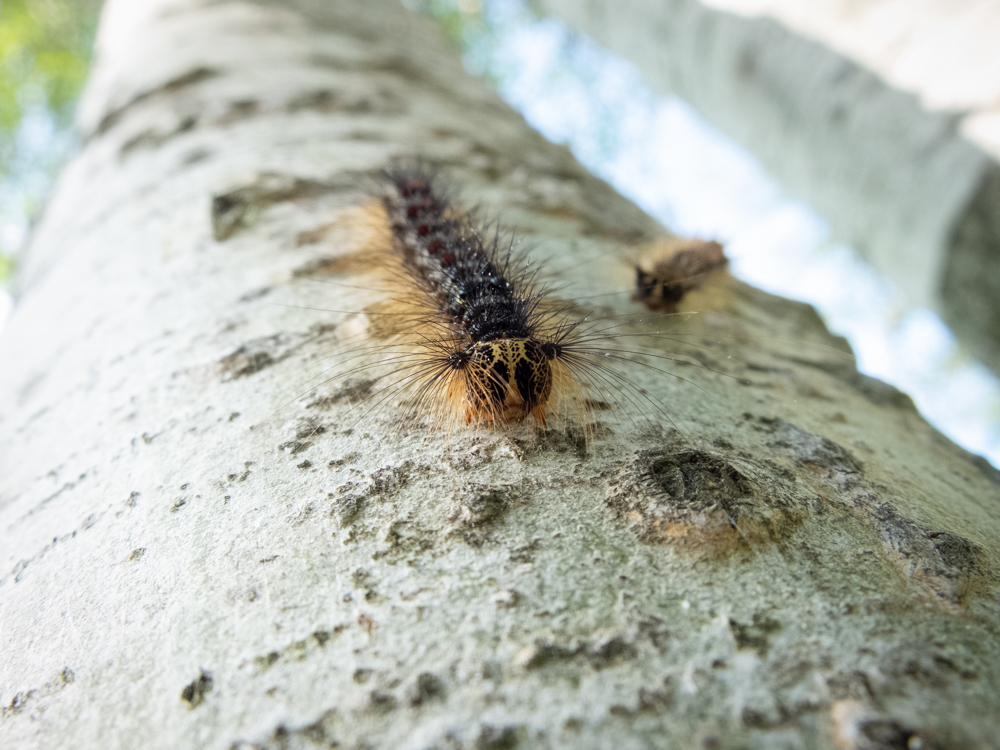WELLINGTON COUNTY – Gypsy moth caterpillars are back with a vengeance throughout Wellington County and they have their eyes set on one thing: your trees.
Native to Europe, the invasive caterpillar was first detected in the province in 1969 and has been chomping away on leaves with population surges reported around every decade or so.
The issue has become so pervasive this year, Erin Mayor Allan Alls says he’s been taking calls from a lot of upset residents wondering why the town isn’t spraying.
But like Wellington’s other municipalities, Erin doesn’t have deep pockets or resources.
“The public thinks you’re ignoring them; well we’re not, we’re just trying to get by like everybody else with what information we have and what we can do,” Alls said, quipping, “The county’s the rich one, but they also have their restraints.”
So, Alls took to county council on May 27, presenting a notice of motion calling on county staff to investigate “the safety, practicality and costs” of aerial spray prior to the annual infestation of the pest next year.
In a recent interview with the Advertiser before county council’s June 24 meeting, Alls said he suspects a sticker-shocked county would say “no way” to dumping money into the problem.
“I may get laughed at by the rest of the councillors, who knows,” he said. At the meeting, Alls said he’s had “nothing but phone calls” from concerned residents.
“The hairs of the caterpillars are full of histamine and when they land on you, in some cases and certainly in mine, I got a lot of welts and itches for a long time,” Alls said.
Ward 3 councillor Campbell Cork said he’s also heard from residents saying they’re “going crazy” with the caterpillars this year.
But if management comes down to mass aerial spraying, Cork said he’s “absolutely and utterly opposed to it.”
Explaining his rationale, Cork said increases of the moths are part of the natural ebb and flow of nature and spraying is not a “precise art” which could negatively affect organic farmers.
“I think if we want to look at a long period of litigation, go to mass spraying, and we’ll get it,” he remarked.
“I don’t see why we want to spend any money or staff time trying to find out how much it might cost to spray the county with some poison.”
Examine options
Ward 7 councillor Don McKay echoed Cork, saying he’d also oppose aerial spraying.
Ward 1 councillor David Anderson said he wants staff to at least examine the options to control the overabundance.
“I think we need some expertise and a report to come back to us on maybe what our direction is as far as the county’s concerns in controlling this,” he said.
Ward 9 councillor Jeff Duncan said he supported Alls’ motion.
“We sort of snicker about it, but you know there’s a real concern there,” Duncan said—a concern large enough to at least look into it.
“This is a little more serious than your run of the mill insects that we’re used to dealing with,” Ward 8 councillor Doug Breen said.
Putting on his agronomy hat, Breen also pointed out the pesticide used to spray the caterpillars—bacillus thuringiensis kurstaki, known as Btk—only targets caterpillars.
“There are good options out there, I don’t know if aerial spraying is the right one, I’m not sure that I’m ready to support that, that’s obviously a huge dollar sign number,” he said. “We need to make sure that we have the latest research and our staff do have a serious look at it because this is not something to be fooled around with.”
Alls said all he wants to accomplish is for staff to examine the options.
“Because we as politicians tell our residents something, but then experts tell them something that’s a little different,” he said.
The motion was seconded by Anderson and passed with one vote opposed.




